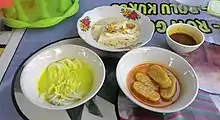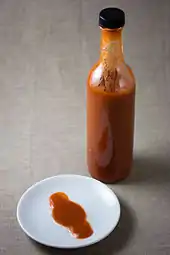Sambal
Sambal is an Indonesian chili sauce or paste typically made from a mixture of a variety of chili peppers with secondary ingredients such as shrimp paste, garlic, ginger, shallot, scallion, palm sugar, and lime juice. Sambal is an Indonesian loan-word of Javanese origin (sambel).[3][4] It is native to the cuisines of Indonesia, and popular in Malaysia, Sri Lanka, Brunei and Singapore.[5] It has also spread through overseas Indonesian populations to the Netherlands and Suriname.
 Traditional sambal terasi served on stone mortar with garlic and lime | |
| Course | Condiments |
|---|---|
| Place of origin | Indonesia[1] |
| Region or state | Java[2] |
| Associated national cuisine | Indonesia, Malaysia, Sri Lanka, Brunei, Singapore, Netherlands and Suriname |
| Serving temperature | Room temperature |
| Main ingredients | Ground chili pepper with shallot, garlic and shrimp paste |
Various recipes of sambals usually are served as hot and spicy condiments for dishes,[6] such as lalab (raw vegetables), ikan bakar (grilled fish), ikan goreng (fried fish), ayam goreng (fried chicken), ayam penyet (smashed chicken), iga penyet (ribs) and various soto soup. There are 212 variants of sambal in Indonesia,[7] with most of them originated from Java.[8]
History
Sambal is often described as Indonesian relish,[9] and it was indeed developed within the Indonesian archipelago. However, its main ingredient, chili pepper of the genus Capsicum, is not native to Southeast Asia. Common variants used in sambal recipes include Cayenne pepper and bird's eye chili pepper (both varieties of Capsicum annuum). These variants are native to the Western Hemisphere and were introduced to the Indonesian archipelago in the 16th century by Portuguese and Spanish sailors during the Columbian exchange.[10]

Curiously, people of the Indonesian archipelago were already familiar with a type of hot and spicy relish prior to the 16th century. A hot spice called "cabya" had become a valuable commodity in the Javanese market as early as the ancient Mataram Kingdom era circa 10th century.[2] The 14th century Majapahit Javanese Nagarakretagama manuscript mentions lombok mirah island which is identified as Lombok island, which is also the area that produced a spice called red lombok. In today's modern Javanese, the term lombok refers to 'chili pepper', yet the term probably originally referred to a native hot spice prior to the introduction of capsicum. The Indonesian languages terms for 'chili pepper' are cabai or cabe, yet the word 'cabya' is mentioned in several ancient inscriptions and texts found in Java from the 10th century CE. Cabya is actually a reference to the Javanese long pepper or Balinese long pepper (Piper retrofractum).[11] Historian suggest that prior to the introduction of Capsicum from the Americas in the 16th century, it was cabya that was widely used and cultivated as a hot spice in Java.[10] Cabya is still used in Java, but the overwhelming popularity of the capsicum plants eventually pushed out cabya consumption until it was only used in traditional herbal medication and in making jamu (Javanese traditional herbal drink). Nowadays, the plant is considered rare.[10] Other historian suggests that it was ginger that was used as a hot spice agent in the ancient form of sambal. Ginger, cabya and andaliman are among the earliest hot spices used in early sambal-like hot relish, followed by the introduction of pepper circa 12th century from India, and finally the introduction of chili pepper from the Americas in the 16th century.[12]
The Javanese manuscript Serat Centhini (1819–1912) records 16 sambal variants in Java.[7] The recipe book Mustika Rasa (1967), written and composed by Hartini Sukarno, presented 63 recipes of sambals.[8] In 2017, Murdijati Gardjito, a food researcher from Gadjah Mada University, identified hundreds variants of sambals in Indonesia; 212 of them have clear origin, while 43 have unclear origin.[7] Java has the most of variants with 43 percent of sambal variants, Sumatra has 20 percent, Bali and West Nusa Tenggara has 8 percent, and the rest are distributed between Maluku, Kalimantan and Sulawesi.[7]
Sambal as a hot and spicy relish most likely originated from Java, as etymology study suggests that the term is a loanword derived from Javanese sambel.[3] Just like many culinary introduction and adaptation in the archipelago, over the years this hot and spicy relish branched off into an assorted array of sambal varieties, localised according to local taste and the availability of the ingredients. Today sambal is a staple of Southeast Asian households, essential in cuisines of Indonesia, Malaysia and Singapore.[13]
Preparation and availability

Traditional sambals are freshly made using traditional tools, such as a stone pestle and mortar. Sambal can be served raw or cooked. There are two main categories of sambals in Indonesia, they are sambal masak (cooked) and sambal mentah (raw). Cooked sambal has undergone cooking process which resulted in a distinct flavour and aroma, while raw sambal are mixed with additional ingredients and usually consumed immediately. Sambal masak or cooked sambals are more prevalent in western Indonesia, while sambal mentah or raw sambals are more common in eastern Indonesia.[8]
The chili pepper, garlic, shallot and tomato are often freshly ground using a mortar, while the terasi or belacan (shrimp paste) is fried or burned first to kill its pungent smell as well as to release its aroma. Sambal might be prepared in bulk, as it can be easily stored in a well-sealed glass jar in the refrigerator for a week to be served with meals as a condiment.[14] However, some households and restaurants insist on making freshly prepared sambal just a few moments prior to consuming to ensure its freshness and flavour; this is known as sambal dadak (lit. "impromptu sambal" or "freshly made sambal"). Nevertheless, in most warung and restaurants, most sambal is prepared daily in bulk and offered as a hot and spicy condiment.
Today some brands of prepared, prepacked, instant, or ready-to-use sambal are available in warung, traditional markets, supermarkets and convenience stores. Most are bottled sambal, with a few brands available in plastic or aluminium sachet packaging. Compared to traditional sambals, bottled instant sambals often have a finer texture, more homogenous content, and thicker consistency, like tomato ketchup, due to the machine-driven manufacturing process. Traditionally made sambals ground in a pestle and mortar usually have a coarse texture and consistency.
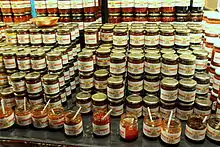
Several brands produce bottled sambals, among others are Huy Fong Foods' sambal oelek,[15][16] Heinz ABC sambal terasi[17] and several variants of sambal Indofood.[18][19]
Varieties of chili
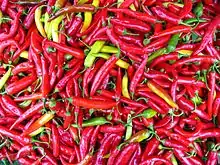
The most common kinds of peppers used in sambal are:
- Adyuma, also known as habanero: a very spicy, yellow, and block-shaped pepper.
- Cayenne pepper: a shiny, red, and elongated pepper.
- Madame Jeanette: a yellow–light green, elongated, irregularly shaped pepper.
- Bird's eye chili, also known as cabe rawit in Javanese: a very spicy, green–red, elongated pepper approximately 10 millimetres (0.39 in) wide and 50 mm (2.0 in) long.
- Chili peppers known as lombok in Javanese: a mild, green–red, elongated pepper. Green chili peppers are milder than red ones.
- Cabe taliwang: a pepper spicier than the Bird's eye chili, similar in spiciness to the naga jolokia, its name is supposedly the origin from which Lombok Island, or "the Island of the Chili", derives its name.
Indonesia

In the Indonesian archipelago, there are as many as 212[7] to 300 varieties of sambal.[20] The intensity ranges from mild to very hot. Some varieties include:
- Sambal andaliman
- Similar to sambal lado mudo but with the addition of andaliman pepper.[21]
- Sambal asam
- This is similar to sambal terasi with an addition of tamarind concentrate. Asam means tamarind or sour or acid in Indonesian.
- Sambal bajak (badjak)
- Banten sambal. Chili (or another kind of red pepper) fried with oil, shallot, garlic, terasi, candlenuts, palm sugar and other condiments. This is darker and richer in flavour than sambal asam.[22]

- Sambal balado
- Minangkabau style sambal. Chili pepper or green chili is blended together with garlic, shallot, red or green tomato, salt and lemon or lime juice, then sauteed with oil.[23] Minang sambal balado often mixed with other ingredients to create a dish, such as egg, eggplant, shrimp or anchovy.
- Sambal bawang
- Sambal made from sliced shallot, chili pepper, garlic, shrimp paste and lemon juice.[24](p32)
- Sambal belimbing or sambal belimbing wuluh
- Sambal made of sour tasting belimbing wuluh (Averrhoa bilimbi), can be found in some places in Indonesia, especially in Java and East Nusa Tenggara.[25]
- Sambal bengkoang
- Jicama (bengkoang) sambal, made from the mixture of jicama or replaced with water chestnut, red chillies, garlic, Asian basil, shrimp paste and lemon juice.[24](p32)
- Sambal bongkot
- A speciality sambal from Bali, a sambal with a mixture of sweet, sour, and spicy flavors, made with bongkot or kecombrang flower stems, shallots, chili, grilled shrimp paste, sugar, salt and lime juice.[26]
- Sambal buah
- (lit: fruit sambal) Speciality of Palembang, made from the mixture of chili, shrimp paste, kemang (a type of mango) and pineapple.
- Sambal cibiuk
- A sambal recipe speciality of Cibiuk village, Garut Regency, West Java. It consist of coarsely chopped and ground green bird's eye chili, green raw tomato, shallot, galangal, lemon basil, shrimp paste and salt.
- Sambal colo-colo
- From Ambon, it consists of Indonesian kecap manis (sweet soy sauce), chili, tomato pieces, shallots and lime it has a chiefly sweet taste. It is suitable for barbecue dishes. Some variations will add butter or vegetable oil to the sambal.
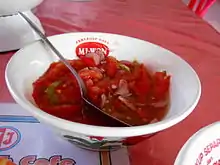
- Sambal dabu-dabu
- Dabu-dabu comes close to the Mexican salsa sauce, it is of Manado's origin. It consists of coarsely chopped tomatoes, calamansi or known as lemon cui or jeruk kesturi, shallots, chopped bird's eye chili, red chili, basil, poured with hot vegetable oil, salt.[27]
- Sambal durian or Sambal tempoyak
- It is made from fermented durian called tempoyak. The fermentation process takes 3 to 5 days. The chili and the tempoyak may be readily mixed or served separately, to cater the individual preference in ratio of chili to tempoyak to determine the scale of hotness. This sambal is available in two varieties: raw and cooked. In the cooked variety, pounded chilis, shallots and lemongrass are stir-fried with anchovies, tempoyak and turmeric leaf (for aroma). Petai (Parkia speciosa) and tapioca shoots are also frequently added. The sweet-sour-hot sambal can be found in Sumatra and Kalimantan (Indonesian Borneo), especially in Palembang and Bengkulu,[28] and also in Malay Peninsula.
- Sambal ebi
- Dried shrimp (ebi) sambal, made from the mixture of dried shrimp, candlenut, galangal, red chillies, shallot, garlic, brown sugar and salt.[24](p33)
- Sambal gandaria
- Freshly ground sambal terasi with shredded gandaria, a kind of tropical fruit native to Southeast Asia.[29]
- Sambal goang
- An extra hot Sundanese sambal associated with the town of Tasikmalaya, made from the mixture of cayenne pepper, garlic, salt and kencur (Kaempferia galanga).[30]
- Sambal goreng
- Literally means "fried sambal". It is a mix of crisp fried red shallots, red and green chili, shrimp paste and salt, briefly stir-fried in coconut oil. It can be made into a whole different dish by adding other ingredients, such as sambal goreng ati (mixed with diced liver) or sambal goreng udang (added with small shrimp).
- Sambal jenggot
- Sambal with an addition of grated coconut, similar to urap.
- Sambal jengkol
- Freshly ground sambal terasi mixed with sliced fried jengkol, a kind of tropical bean with slightly stinky aroma native to Southeast Asia. Sambal jengkol can be found in Sundanese and Cirebon cuisine.[31]
- Sambal kalasan
- Sometimes also called sambal jawa, a Javanese stir fried sambal similar to sambal tumis. It uses a heapful of gula jawa palm sugar which gives its dark brown colour, tomato, spices and chili. The overall flavour is sweet, with mild hints of spices and chili.
- Sambal kacang
- A mixture of chilli with garlic, shallot, sugar, salt, crushed fried peanuts, and water. Usually used as condiments for nasi uduk, ketan, or otak-otak. The simple version only employ cabe rawit chilli, crushed fried peanuts and water.
- Sambal kecap
- A sambal consists of Indonesian kecap manis (sweet soy sauce), red chili, tomato pieces, shallots and lime, it has a sweet and spicy taste and usually used for barbecue dishes.[14]
- Sambal kecombrang
- A sambal made from kecombrang (Etlingera elatior) flower, mixed with red cayenne pepper, shallot, garlic, salt and lime leaves.[32]
- Sambal kemiri
- This is similar to sambal terasi with an addition of candlenuts.
- Sambal kenari
- Sambal made with a mixture of kenari (Canarium ovatum) nut, speciality of Maluku islands.[33](p8)

- Sambal lado mudo or sambal ijo
- Literally a Minangkabau word for "green sambal". It is also known as sambal hijau or sambal ijo, also "green sambal". Sambal lado mudo, a West Sumatran speciality, used green chili, stir fried with dried shrimp, red shallots, garlic, and spices. It is less hot compared to common sambals, and has a fresh flavour that complements the richness of Sumatran food.
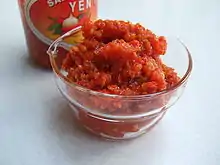
- Sambal lampung
- A popular variant of slightly sweet chili, garlic, tomato sambal of Lampung origin, Sumatra.[34]
- Sambal leunca
- A Sundanese sambal, especially popular in West Java, made with the mixture of red chili pepper, bird's eye chili, shallot, shrimp paste and leunca (Solanum nigrum) berries.[35]
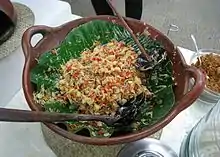
- Sambal luat
- Sambal made of the mixture of red chili pepper, terasi shrimp paste, key lime juice, shallot, scallion, coriander, tomato, salt. Specialty of East Nusa Tenggara province.[36] Usually consumed as a condiment to accompany Se'i smoked pork or beef.
- Sambal matah
- Raw shallot and lemongrass sambal of Bali origin. It contains a lot of finely chopped shallots, chopped bird's eye chili, lemongrass, cooking oil with a dash of lime juice.[37]
- Sambal petai
- A mixture of red chili, garlic, shallot, and petai green stinky bean as the main ingredients.
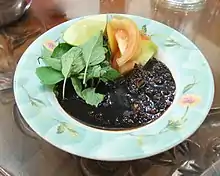
- Sambal petis
- An east Javanese sambal uses chili, petis (a kind of shrimp paste), peanuts, young banana, herbs and spices.[38]
- Sambal pencit/mangga muda
- Green mango sambal[24](p32) from Central Java. Freshly ground sambal terasi with shredded young unripe mango. This is a good accompaniment to seafood. Pencit means young mango in Indonesian.[14][6]
- Sambal plecing
- Originating from Lombok island, the sambal consists of Lombok's chili variety and Lombok's lengkare shrimp paste, tomatoes, salt, and lime juice.
- Sambal rica rica
- A hot sambal from Manado region, it uses ginger, chili, lemon and spices. Suitable for barbecue meats and chicken.[39]
- Sambal roa
- Spicy smoked roa fish (halfbeak) sambal from Manado region, North Sulawesi.[40]
- Sambal rujak
- Rujak spicy sauce, made from palm sugar, tamarind, chili pepper and shrimp paste.[6]
- Sambal setan
- A very hot sambal with Madame Jeanette peppers (red brownish, very sharp). The name literally means "devil's sauce". It is popular in Surabaya.[41]
- Sambal taliwang
- This variant is native to Taliwang, a village near Mataram, Lombok Island, and is made from naga jolokia pepper grown specially in Lombok, garlic and Lombok shrimp paste. A kilogram of naga jolokia pepper is extracted, ground and pressed. This is mixed with ground garlic and shrimp paste, then cooked with vegetable oil.
- Sambal tauco
- A Sulawesi sambal, contains the Chinese tauco, lime juice, chili, brown sugar, and salt.[14][6]

- Sambal terasi
- A common Indonesian style of sambal.[42] Similar to the Malaysian belacan, but with a stronger flavour, since terasi is more tangy and fermented. Red and green peppers, terasi, sugar, salt, lemon or lime juice (tangy, strong).[14][43][6] One version omits the lime juice and has the sambal fried with pounded tomatoes. Popularly eaten raw. Alternate spelling in the Netherlands: trassi or trassie.
- Sambal teri lado
- A Padang speciality, sambal is made using chili pepper, tomato, shallot, spices, and mixed with salted ikan teri (anchovy). The sambal is stir fried and similar to Malay "sambal ikan".[44]

- Sambal tomat
- Similar to sambal tumis but with the addition of crushed tomato and sugar. It can be served as fresh sambal or stirred sambal. The tomato is stir fried along with the other ingredients until a paste like consistency. The overall taste is hot and sweet, it is a good mix with lalapan. For very young children, sambal tomat sometimes use very little or no chili at all, it is regarded as one of the first steps in introducing children to the taste of Indonesian sambal.
- Sambal Tuktuk
- It is a Batak andaliman (Sichuan pepper) and aso-aso fish (dried and preserved mackerel) sambal from North Sumatra.[45]
- Sambal tumis
- Chili fried with belacan shrimp paste, onions, garlic, tamarind juice. Tumis means "stir fry". Often the cooking oil is re-mixed with the sambal. It may be mixed with other ingredients to produce dishes such as sambal kangkong, sambal cumi (squid) and sambal telur (egg).[46]
- Sambal tumpang
- Javanese sambal made from the mixture of chili pepper, other spices and semangit (old and pungent) tempeh.[47]
- Sambal udang bawang
- A speciality sambal from Surabaya. It is one of Indonesia's super hot sambal. It used simple ingredients, such as chili pepper, shallot, garlic, asam jawa (tamarind) and coconut oil. People of Surabaya often called it Njaluk Sambal, as they eat it with fragrant steamed white rice.

- Sambal ulek (oelek)
- Raw chili paste (bright red, thin and sharp tasting). Can be used as the base for making other sambals or as an ingredient for other cuisines. Some types of this variant call for the addition of salt or lime into the red mixture. Oelek is a Dutch spelling which in modern Indonesian spelling has become simply ulek; both have the same pronunciation. Cobek is Indonesian special stoneware derived from common village basalt stone kitchenware still ubiquitous in kitchens, particularly in Java. The cobek is a mortar shaped like a hybrid of a dinner and soup-plate with an old, cured bamboo root or stone pestle (ulek or ulekan) employed in an ulek manner: a crushing and twisting motion (like using a screwdriver) for crushing lime leaves, chilies, peppers, shallots, peanuts, and other kinds of ingredients.
- Sambal stroberi
- A sambal made with strawberries originated from Bandung, West Java. Usually served to accompany breaded fish cutlet.[48]

- Sambal uyah-lombok
- A kind of sambal which is only made from raw chilli and salt. Very simple and easy to make, and usually be eaten with steamed rice and fried foods like fried chicken.
Malaysia
- Sambal belacan
- A Malay style sambal. Fresh chilies are pounded together with toasted shrimp paste (belacan) in a stone mortar to which sugar and lime juice are added. Originally, limau kesturi or calamansi lime, is used but since this is scarce outside of Southeast Asia, normal lime is used as a replacement.[49] Tomatoes are optional ingredients. Sometimes, sweet sour mangoes or equivalent local fruits are also used. It can be eaten with cucumbers or ulam (leafy herbs) in a meal of rice and other dishes. A Malaysian-Chinese version is to fry belacan with chili.[50]
- Sambal jeruk
- Green or red pepper with kaffir lime. In Malaysia, it is called cili (chili) jeruk (pickle). Sometimes vinegar and sugar are substituted for the lime. Used as a condiment with fried rice and noodle-based dishes.
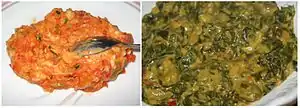
- Sambal tempoyak
- This sambal exists in two varieties: raw and cooked. Raw sambal tempoyak is prepared from fresh chilis pounded together with dried anchovies and served with fermented durian (tempoyak). The sambal and the tempoyak may be readily mixed or served separately, so that the person eating can determine the ratio of sambal to tempoyak that they want (tempoyak has a sweet-sour taste that offsets the hotness of the chili). In the cooked variety, pounded chilis, shallots and lemongrass are stir-fried with anchovies, tempoyak and turmeric leaf (for aroma). Commonly found in Pahang and Perak of Peninsular Malaysia, sambal tempoyak could be found also at Sumatra. Petai (Parkia speciosa) and tapioca shoots are also frequently added.
- Sambal Kicap
- Made from mixed of sweet soya sauce, shallot, garlic, bird's eye chili for any fried dishes especially for fried banana, fried tempeh or condiment for soto and bihun soup.
- Sambal Goreng
- Dishes consist of tempeh, anchovies, peanut fried together with sambal until dried.
- Sambal Petai
- Sambal Kacang
- Condiment for satay.
- Sambal Tok Tok
- Sweet Sambal
- This is a sambal made from dried chilies, fresh chilies, belacan and gula Melaka (palm sugar) as main ingredients. Sweet sambal is traditionally served with nasi lemak and also side dishes fried crispy anchovies, toasted peanuts, boiled egg and cucumber.[51]:
Sri Lanka
- Sini sambal
- This is a sambal of the Sri Lankan cuisine that includes onion, crumbled Maldive fish, and spices as its main ingredients. Its name, also spelled as "sini sambol" and "seeni sambal", is derived from the local word for "sugar".[52]
- Pol sambal/Thengkai sambal
- This is a sambal made of scraped coconut (pol and thengkai mean coconut in Sinhala and Tamil, respectively), onion, green chili, red chili powder, and lime juice as its main ingredients. Sometimes, crumbled Maldive fish is also added, and tomatoes can be used instead of lime juice for flavour.[52]
- Lunu miris (Katta sambal)
- The name "lunu miris" can be literally translated as "salt chili" and is a paste of red chili pounded with sea salt. A widespread derivative is katta sambal, which adds onions, crumbled Maldive fish, salt, and lime juice to the chili-and-salt mixture.[52]
- Vaalai kai sambal
- This is a sambal made of boiled and mashed plantain, scraped coconut, chopped green chilies and onion, salt and lime juice. Vaalai kai means unripe plantain in Sri Lankan Tamil.
Dishes
Sambal can also be used as an ingredient to a dish, which uses a large amount of chili peppers. In Padang cuisine, any dishes started with balado- (lit: with chili pepper) indicate the sambal-mixed dish. Dishes bearing the word sambal include:
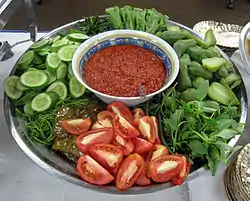
- Sambal lalab
- Sambal served with lalab (assorted of fresh vegetables), consumed as a dip dressing for salad.
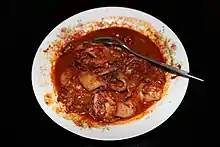
- Sambal sotong or Sambal cumi
- (with cuttlefish)
- Sambal udang kering
- (with dried prawns), also known in Penang as "Sambal Hae Bee"
- Sambal lengkong
- (with ikan parang/wolf herring).[53]
- Sambal goreng teri kacang
- (with anchovy and peanuts)
- Sambal goreng kering tempe
- (with tempeh)

- Sambal goreng ati
- (with cow's or chicken liver, potato, and sometimes petai)
- Sambal goreng udang
- or sambal shrimp (with fresh shrimp), also known as udang balado.
- Sambal radio
- a traditional dish from Sarawak, it is an omelette mixed with fried belacan and anchovies.
- Sambal ikan
- a Malay-style dish prepared from fish and spices and cooked until the fish loses its shape. Available in varieties, some are in the shape of dry fish floss known as serunding ikan, and some are moist such as sambal ikan bilis (anchovies) or sambal ikan tongkol (skipjack tuna).
- Sambal daging/serunding daging
- A Malay style sambal prepared from meat and spices and cooked for more than 4 hours until the meat loses its shape, similar to meat floss.[54]
See also
- Balado, Minang style sambal goreng
- Hot sauce, also known as chili sauce or pepper sauce
- Indonesian cuisine
- Malaysian cuisine
- Nam phrik, the Thai equivalent of sambal
- Singaporean cuisine
- Peranakan cuisine
- Filipino cuisine
References
- Sara Schonhardt (25 February 2016). "40 Indonesian foods we can't live without". CNN.
- Media, Kompas Cyber. "Sejak Kapan Masyarakat Indonesia Mengonsumsi Sambal?". KOMPAS.com (in Indonesian). Retrieved 23 June 2019.
- Sri Nardiati (1993). Kamus bahasa Jawa-bahasa Indonesia. Jakarta, Indonesia: Pusat Pembinaan dan Pengembangan Bahasa, Departemen Pendidikan dan Kebudayaan. ISBN 9794593818.
- Faldela Williams (1988). Cape Malay Cookbook. Struik. p. 58. ISBN 9781868255603.
- "The big chilli sauce guide: how to tell your sriracha from adobo". Retrieved 22 April 2017.
- Heinz Von Holzen; Lother Arsana (2015). The Food of Indonesia: Delicious Recipes from Bali, Java and the Spice Islands, Periplus world cookbooks. Tuttle Publishing. ISBN 9781462914913.
- "Ada 212 Jenis Sambal di Indonesia, Berasal Dari Mana Sajakah? – Semua Halaman – Nationalgeographic.grid.id". nationalgeographic.grid.id (in Indonesian). Retrieved 28 June 2019.
- Media, Kompas Cyber. "212 Jenis Sambal di Indonesia, Ternyata Paling Banyak Berasal dari Jawa". KOMPAS.com (in Indonesian). Retrieved 28 June 2019.
- "Sambal | Indonesian relish". Encyclopædia Britannica. Retrieved 23 June 2019.
- Post, The Jakarta. "Meet 'cabya', chili pepper's weird great uncle". The Jakarta Post. Retrieved 23 June 2019.
- Hananto, Akhyari. "Inilah 'Nenek Moyang' Cabai yang Asli Indonesia". Good News From Indonesia (in Indonesian). Retrieved 23 June 2019.
- Media, Kompas Cyber. "Bukan Cabai, Sambal Pertama di Nusantara Terbuat dari Jahe". KOMPAS.com (in Indonesian). Retrieved 23 June 2019.
- Pattillo, Natalie (13 August 2018). "Sambal, a Pungent Reminder of Home and Hardship". The New York Times. ISSN 0362-4331. Retrieved 23 June 2019.
- Arsana, Lother (2013). Authentic Recipes from Indonesia. Tuttle Publishing. pp. 31–33. ISBN 9781462905355. Retrieved 9 February 2015.
- "David Tran: How a Vietnamese Refugee Founded a Multi-Million Dollar Sriracha Empire". Retrieved 22 April 2017.
- "A Brave New World Of Sambal Sauces". 14 September 2016. Retrieved 22 April 2017.
- Devita Sari (5 April 2011). "'Homestyle Sambal Terasi' Lezat dan Praktis". detikFood (in Indonesian).
- "Sambal Indofood". Indofood.
- "Sambal Indofood". vemale.com. 2 August 2012.
- "Some Like It Hot! Bali Safari and Marine Park Holds Its 3rd Chili Festival". Bali Discovery Tours.
- "Andaliman Pepper Sambal". Indonesia Eats.
- Sarah Raven (27 September 2014). "Sambal Badjak recipe, a classic recipe for Indonesian pickle". The Telegraph.
- Pepy Nasution (7 August 2008). "Balado, The Tangy Chili Sambal from West Sumatra". Indonesia Eats.
- Holzen, Heinz Von; Arsana, Lother (17 April 2012). Authentic Recipes from Indonesia. Tuttle Publishing. ISBN 9781462905355.
- Femalesia. "Pedasnya Sambal Belimbing Khas NTT Bikin Keringat Mengucur". Femalesia (in Indonesian). Retrieved 2 November 2020.
- "Sambal Bongkot, Masakan Bali yang Menggoyang Lidah | GreatnessIndonesia.com". Greatness Indonesia (in Indonesian). 6 August 2018. Retrieved 10 February 2020.
- "Dabu-Dabu – Indonesian Salsa". Traveling Chili. Archived from the original on 10 April 2017. Retrieved 9 April 2017.
- "Sambal Tempoyak (Bengkulu)". Melayu Online. Archived from the original on 10 July 2014. Retrieved 28 October 2011.
- "Sambal Gandaria". Cookpad (in Indonesian).
- Mustinda, Lusiana. "Huah! Pedasnya Sengatan Sambal Goang Khas Tasikmalaya". detikfood (in Indonesian). Retrieved 11 February 2020.
- "Sambel Jengkol". Bango (in Indonesian).
- "Resep Sambal Kecombrang". Femina. 16 July 2017. Retrieved 12 February 2020.
- Demedia, Tim Dapur (2008). Aneka Sambal Nusantara (in Indonesian). DeMedia. ISBN 9789791471367.
- "Sambal Lampung – Lampung Chili Sauce". dailycookingquest.com. Retrieved 29 December 2018.
- "Sambal Leunca". Femina. 28 June 2011. Retrieved 12 February 2020.
- "Resep Sambal Luat Khas NTT Pedasnya Mantap". MerahPutih (in Indonesian). 24 February 2017. Retrieved 2 November 2020.
- "Raw Balinese sambal (sambel matah)". SBS.
- "Sambel Petis". Bango (in Indonesian).
- Anita (23 June 2013). "Ayam Rica Rica". Daily cooking Quest.
- "Sambal Roa". Femina (in Indonesian). 11 January 2014.
- "Sambal Setan". Cookpad (in Indonesian).
- Anita (7 August 2013). "Lalap Sambal Terasi – Sundanese Vegetables with Shrimp Paste Chili Relish". Daily Cooking Quest.
- Brissenden, Rosemary (2007). Southeast Asian Food, Classic and modern dishes from Indonesia, Malaysia, Singapore, Thailand, Laos, Cambodia and Vietnam. Periplus. p. 161. ISBN 978-0794604882. Retrieved 31 October 2014.
- "Sambal Teri Lado". Cookpad (in Indonesian).
- "Sambal Tuk-Tuk Recipe (Andaliman Fish Sambal)". IndonesiaEats. 16 August 2012. Retrieved 3 April 2014.
- "Sambal Tumis (Fried Chilli Paste)". Noob Cook. 3 March 2014.
- "Sambal Tumpang (Javanese Old Tempe Sambal)". Indonesia Eats. 4 November 2010. Retrieved 11 February 2020.
- "Fried Fish With Strawberry Sambal". Femina. 5 January 2015.
- "Sambal Belacan – Easy Delicious Recipes: Rasa Malaysia". Retrieved 22 April 2017.
- "Full text of "A descriptive dictionary of British Malaya [microform]"". Retrieved 22 April 2017.
- "Nasi Lemak Lover: Easy Sweet Sambal with Gula Melaka". nasilemaklover.blogspot.my. Retrieved 14 July 2016.
- Gunawardena, Charles A. (2005). Encyclopedia of Sri Lanka. Sterling Publishers Pvt. Ltd. p. 96. ISBN 9781932705485.
- Ng, D. (1979.) Dorothy Ng's Complete Asian Meals, Times Books International, Singapore.
- "Freeman, Charles 1933– – Dictionary definition of Freeman, Charles 1933– – Encyclopedia.com: FREE online dictionary". Retrieved 22 April 2017.
